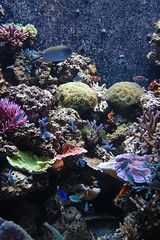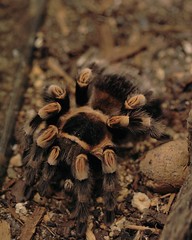 The Smithsonian Museum of Natural History dates back to 1910. With 325,000 square feet of exhibition and public space, and more than 126 million specimens and cultural artifacts in the collection, you're sure to find something of interest. Our strategy is usually to pick two or so exhibits that we want to focus on; more than that, and our eyes start to glaze over.
The Smithsonian Museum of Natural History dates back to 1910. With 325,000 square feet of exhibition and public space, and more than 126 million specimens and cultural artifacts in the collection, you're sure to find something of interest. Our strategy is usually to pick two or so exhibits that we want to focus on; more than that, and our eyes start to glaze over.Permanent Exhibits
 The new Ocean Hall is now the museum's largest permanent exhibition. It includes many specimens of ocean creatures, videos, and a tropical fish tank that gets all the toddlers screaming "NEMO!!!". The sit-down movie on deep sea exploration is a nice way to rest your feet. And in one of the display cases on diversity, there's a video on squid camouflage that's pretty incredible. This place is full of sensory overload; you'll probably stumble upon other things that we missed entirely.
The new Ocean Hall is now the museum's largest permanent exhibition. It includes many specimens of ocean creatures, videos, and a tropical fish tank that gets all the toddlers screaming "NEMO!!!". The sit-down movie on deep sea exploration is a nice way to rest your feet. And in one of the display cases on diversity, there's a video on squid camouflage that's pretty incredible. This place is full of sensory overload; you'll probably stumble upon other things that we missed entirely.The Hall of Geology, Gems, and Minerals is home to the Hope Diamond as well as 3,500 other specimens including gems, minerals, rocks, and meteorites. We often think of nature as living creatures, but there's just as much of interest in the geological world, and the highlights are concentrated here.
 The Insect Zoo is one of the things I still clearly remember from my trip to the museum when I was in second grade. This is indeed a zoo -- all the insects are alive, including pupating butterflies, honeybees coming and going through the wall of the museum into their enclosed hive, and tarantulas, which get fed three times a day. As you emerge from the insect zoo, there is a small butterfly enclosure that you can pay to walk through. It's free on Tuesdays. (There are also a few interesting displays on how butterflies and plants have co-evolved, which you don't have to pay for.)
The Insect Zoo is one of the things I still clearly remember from my trip to the museum when I was in second grade. This is indeed a zoo -- all the insects are alive, including pupating butterflies, honeybees coming and going through the wall of the museum into their enclosed hive, and tarantulas, which get fed three times a day. As you emerge from the insect zoo, there is a small butterfly enclosure that you can pay to walk through. It's free on Tuesdays. (There are also a few interesting displays on how butterflies and plants have co-evolved, which you don't have to pay for.)Birds of D.C. is a permanent exhibit of stuffed birds whose living counterparts may be seen in DC. It's an opportunity to bone up on your bird ID and get a good look at some of the birds that are trickier to spot.
The Discovery Room has hands-on exhibits of fossils, skulls, shells, minerals, and microscope specimens, open for you to put your paws on from 10:30 to 3:30 daily except Mondays.
 The Hall of Mammals includes stuffed specimens, skeletons, fossils, and an educational video about evolution under the somewhat corny, but kid-friendly premise of a "mammal family reunion." The animals come from all over the world, and give a sense of species diversity, but aren't as helpful for trying to learn about our local fauna. Similarly, there's a Hall of Reptiles.
The Hall of Mammals includes stuffed specimens, skeletons, fossils, and an educational video about evolution under the somewhat corny, but kid-friendly premise of a "mammal family reunion." The animals come from all over the world, and give a sense of species diversity, but aren't as helpful for trying to learn about our local fauna. Similarly, there's a Hall of Reptiles.Of course, the Hall of Paleontology is even less helpful in learning about modern, local animals. But it's still pretty cool.
Current Special Exhibits:
Farmers, Warriors, Builders: The Hidden Life of Ants is primarily an exhibit of really large photographs of ants. But not just any ants: ants that are fighting, farming, and dramatically affecting the environment they live in. There's a small colony of leafcutter ants set up in a contraption of gerbil tubes. More interesting, to me, was a metal casting of a fire ant colony, which at first we thought was just abstract art. Through October 10, 2009.
Dig It! The Secrets of Soil - We haven't made it to this exhibit yet, but it claims to be a "journey into the skin of the earth" in which you will "discover the amazing connections between soils and everyday life, and think about this hidden world in a whole new way." Cool. Through Jan. 2010.


